The next-gen MacBook Pro with Retina Display Review
by Anand Lal Shimpi on June 23, 2012 4:14 AM EST- Posted in
- Mac
- Apple
- MacBook Pro
- Laptops
- Notebooks
Last year when I wrote about the new MacBook Airs I offered two forward looking paragraphs:
What happens from here on out is what's really interesting. Intel has already committed to moving the TDP of its mainstream parts from 35W - 45W down to 10 - 20W. Since the Air is the new mainstream Mac notebook, Apple has already made that move. The performance in this 10 - 20W segment is going to get much better over the next two years, particularly once Haswell arrives.
The Thunderbolt Display is the first sign of what's to come. Moving IO controllers and expansion into the display, and potentially even moving discrete GPUs out of the notebook are all in store for us. Apple is really ahead of the curve here, but it's easy to imagine a future where laptops become a lot more like the new Air and shift to a couple high bandwidth ports instead of numerous lower bandwidth connections.
Perhaps I was being too aggressive in the prediction of a couple of high bandwidth ports. After all, the next-generation MacBook Pro with Retina Display features four such IO ports (2 x Thunderbolt and 2 x USB 3.0). But you get my point. Gigabit Ethernet and Firewire 800 are both gone. The discrete GPU is still present but I suspect even its days are numbered, at least inside the chassis. The personal computer as we knew it for so long, is changing.
The personal computer is getting thinner, lighter, more integrated and more appliance-like. The movement is no longer confined to just Apple either. The traditional PC OEMs are following suit. Even Microsoft has finally entered the PC hardware business, something it threatened to do for years but hadn't until now. Distribution models will change, the lines between different form factors will continue to blur. What was once a mature industry is going through a significant transformation. It’s exciting but at the same time it makes me uneasy. When I first got into this industry everyone had stories of companies with great ideas that just didn’t make it. As we go through this revolution in computing I’m beginning to see, first hand, the very same.
Apple makes the bulk of its revenue from devices that don’t look like traditional personal computers. For the past couple of years I’ve been worried that it would wake up and decide the traditional Mac is a burden, and it should instead be in the business of strictly selling consumer devices. With its announcements two weeks ago in San Francisco, I can happily say that my fears haven’t come true. At least not yet.
It’s been a while since Apple did a really exciting MacBook Pro launch. Much to my surprise, even the move to Sandy Bridge, the first quad-core in a MacBook Pro, was done without even whispers of a press conference. Apple threw up the new products on its online store, shipped inventory to its retail outlets, updated the website and called it a day. Every iPhone and iPad announcement however was accompanied with much fanfare. The MacBook Pro seemed almost forgotten.
With its WWDC unveil however Apple took something that it had resigned to unexciting, dare I say uncool status, and made a huge deal about it. Two weeks ago Apple did the expected and offered relatively modest upgrades to all of its portable Macs, all while introducing something bold.
Apple calls it the MacBook Pro with Retina Display. You’ll see me refer to it as the next-gen MacBook Pro, Retina MacBook Pro, rMBP or some other permutation of these words.
After using it for the past two weeks I can honestly say it’s the best Mac Apple has ever built. And there’s a lot more to it than hardware.
Portability
If you were hoping for a 15-inch MacBook Air, that’s not what the rMBP is. Instead it is a far more portable 15-inch MacBook Pro. I have to admit I was a bit let down the first time I laid eyes on the next-gen MacBook Pro, it looks good but it doesn’t look all that different. The disappointment quickly faded as I actually picked up the machine and started carrying it around. It’s not ultra light, but man does it make the previous chassis feel dated.
While I never really liked lugging around the old MBP (and it always made me feel like the old fogey at tradeshows where everyone else had something 13-inches or smaller), carrying the rMBP is a pleasure by comparison. Pictures really don’t do it justice. The impressively thin display assembly or overall chassis thickness look neat in a photo but it’s not until you actually live with the rMBP that you can appreciate what Apple has done here. I carry around a 15-inch MacBook Pro because it’s my desktop, and as such it’s incredibly useful to have with me when I travel. For my personal usage model, the Retina MacBook Pro is perfect.
If your workload demands that you need the performance of a MacBook Pro and your lifestyle requires you to carry it around a lot, the reduction in thickness and weight alone will be worth the upgrade to the rMBP. If you spend most of your time stationary however, you’ll have to be sold on the display and internal characteristics alone. The bad news is if the design doesn’t get you, everything else will.

From left to right: 11-inch MacBook Air, 13-inch MacBook Air, 15-inch MacBook Pro, MacBook Pro with Retina Display
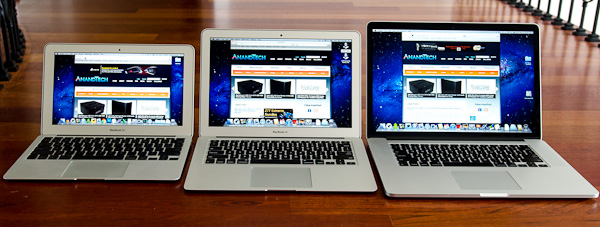
From left to right: 11-inch MacBook Air, 13-inch MacBook Air, MacBook Pro with Retina Display
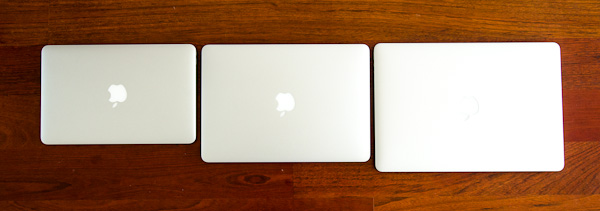
From left to right: 11-inch MacBook Air, 13-inch MacBook Air, MacBook Pro with Retina Display


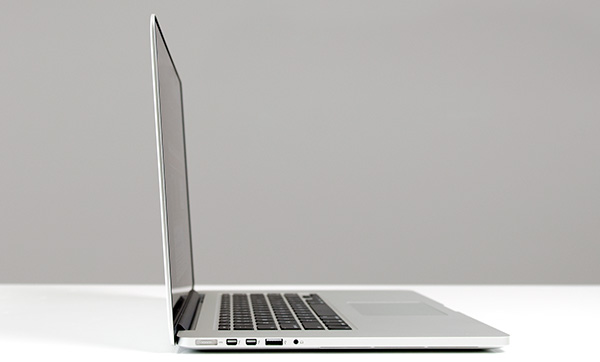
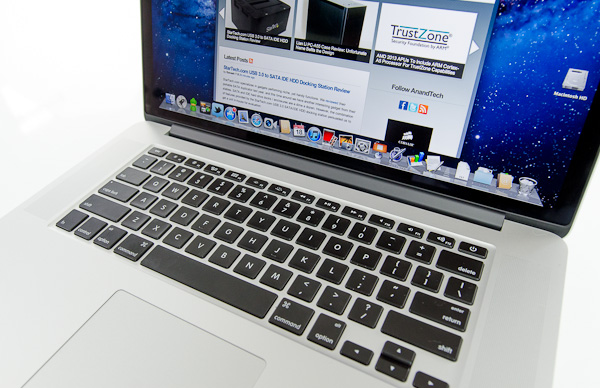
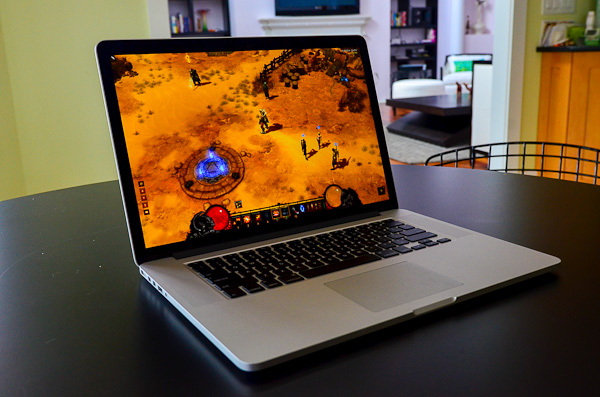
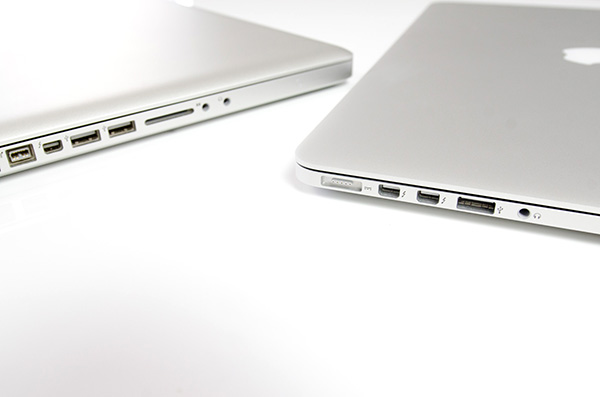
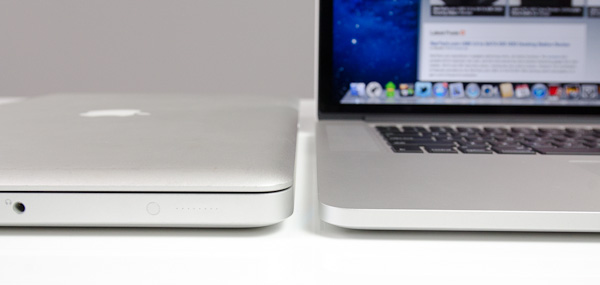








471 Comments
View All Comments
KoolAidMan1 - Friday, July 6, 2012 - link
Please, MBAs have always had good CPUs, and what is happening now with Ivy Bridge is nothing new.I get it, in your world, Ivy Bridge is magically low when it is in an Apple laptop, got it.
Your argument is undermined because you have none, and your name calling only nails down how desperate you are.
Spunjji - Tuesday, June 26, 2012 - link
Idiot.KoolAidMan1 - Saturday, June 23, 2012 - link
16:9 display, who cares?Ohhmaagawd - Saturday, June 23, 2012 - link
"Rubbish, there are plenty of other companies who are far more innovative than Apple whose machines look basic in comparison - Sony's older Z series had a very high resolution 13.1in 1080p screen, blu-ray writer, quad SSDs in RAID 0, integrated and discrete graphics card and the fastest of te dual core i7's while still smaller and lighter than Apple's 13in machines and that was a couple of years ago. Apple aren't even close to touching most of its technology and probably never will."how is any of that innovative? Quad SSDs/RAID 0 is pretty cool - i'll get them that. But other than that? I looked at these things. They have freaking VGA ports. They look like decent machines with above average designs, but that's about it.
So what's innovative about apple laptops? mag safe. glass trackpads that don't suck (no one else makes a useable trackpad IMO). unibody aluminum case. magnetic latch system is unmatched. event the little prongs on the small power supply are nicer than anything else I've see. ability to sleep and wake up :) (I still haven't used a Windows laptop that consistently can do this). backlit keyboard. thunderbolt connector (first on mac) allows you to realistically use only two connections - thunderbolt for display/data and power. first to have ultra thin laptops (Air). and now the retina display.
OCedHrt - Sunday, June 24, 2012 - link
As others answered, the VGA ports is because many projects use VGA still and the target is upper management and enthusiasts. This comes from Japan's management hierarchy. Except Sony to refresh with a dongle of some kind in the future now that Apple doesn't have an exclusive on thunderbolt.Ohhmaagawd - Sunday, June 24, 2012 - link
Thunderbolt was never mac exclusive: http://www.pcmag.com/article2/0,2817,2380954,00.as...And any company could have used display port as apple did previously.
Answer to the projector prob is a dongle (that's what I do). Or buy a decent projector. Or better yet - just get an HDTV.
Spunjji - Tuesday, June 26, 2012 - link
Oh sure, buy a decent projector for every client you're visiting on your business trips. Problem solved!Dumbass.
vegemeister - Monday, July 2, 2012 - link
>They have freaking VGA ports.Er, how is this a problem?
kmmatney - Sunday, June 24, 2012 - link
Too bad Sony doesn't have the balls to make a 16:10 display.ramb0 - Monday, June 25, 2012 - link
yeah sure. The Finger Swipe security feature is probably the best innovation outside of Apple. I mean, that feature totally took off. It's amazing Apple hasn't caught on yet. I guess they're too busy innovating features that people actually give a fuck about. And by "people" i'm talking about the majority, not little nit pick wankers like you.